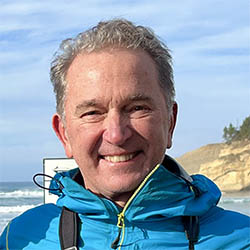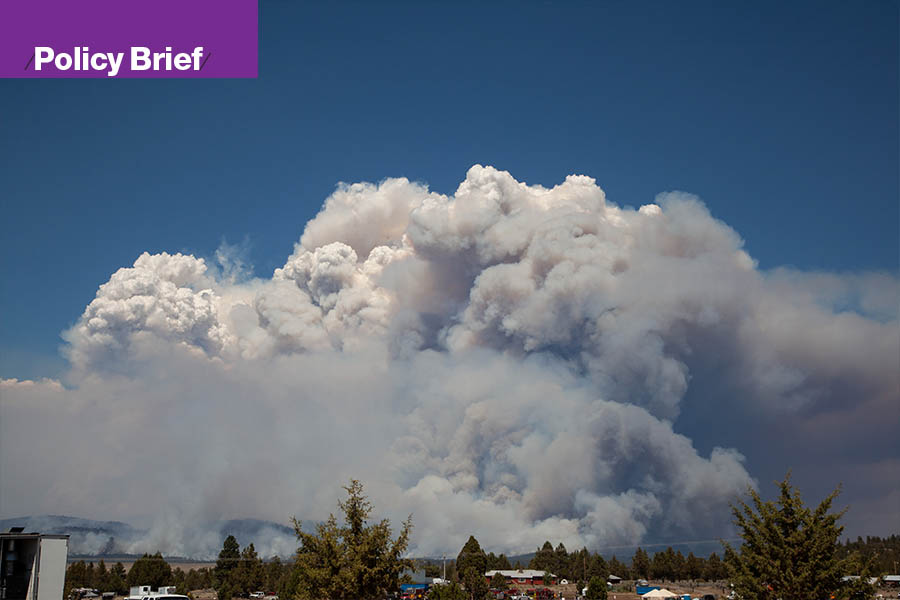Dr. Douglas Toomey, who leads the Oregon Hazards Lab, writes about an AI tool that could make it easier to detect and combat wildfires.
Oregon summers are cherished for limitless opportunities to recreate, gather with family and friends, and be outdoors to enjoy the abundance of natural beauty that surrounds us. However, these traditions increasingly are being disrupted by devastating wildfires resulting in injuries, loss of life, destruction of communities and blanketing the region for days with hazardous, polluted air. As we commence this wildfire season, firefighters in the Pacific Northwest are facing a growing challenge, but new tools offer hope for early detection.

Each year, as climate change intensifies and extends the region’s wildfire season, we have seen some of the most destructive fires our state has ever experienced. Unfortunately, researchers agree that the trend will likely only worsen, with recent studies showing that the risk for fires in Oregon and Washington will double by 2035. As these events grow more intense and costlier for our state and public health, it’s becoming clear our first responders need more support. Rapid advancement of real-time multihazards alerting networks and artificial intelligence (AI) are areas University of Oregon is leading to create beneficial uses to offer emergency officials in Oregon and other states across the Pacific Northwest a new leg up in the fight.
Several states in the western U.S. are already exploring and implementing cameras powered by AI to help combat wildfires. These high-tech cameras can survey large areas with a 360-degree view of the surrounding landscape while employing advanced algorithms to detect and alert first responders to fire starts. This technology has enabled responders to reach and contain wildfires faster. However, the networks these cameras are built on have always been small or fragmented, limiting the amount of critical data firefighters can access.
To tackle this limited accessibility, the Oregon Hazards Lab (OHAZ) at the University of Oregon has partnered with the University of Nevada, Reno, and the University of California, San Diego, to form the world’s largest public-facing system of wildfire cameras. Together the combined networks create a web of 1,200 high-tech cameras throughout the western United States. While the universities will own and operate their real-time sensor networks, its data will be accessible to firefighters through a single intuitive platform called ALERTWest.
ALERTWest offers a cutting-edge interoperable platform designed to heighten situational awareness for emergency personnel. Through the integration of this vast camera network, the ALERTWest platform allows for easy access to real-time wildfire monitoring. The public can view live camera feeds for situational awareness, while firefighters can obtain secure web access for direct camera control. Meanwhile, its advanced machine-learning algorithms detect and notify an operations center of fires soon after ignition. When the operations team verifies and confirms a location, alerts are sent to dispatchers, giving them the crucial window they need to mitigate fires before they spread out of control.
Our sensor networks are also useful before and after a fire begins. Prior to ignition, the cameras and other sensors are used to evaluate fuels and weather, important factors in assessing hazardous conditions. After ignition, the cameras can provide critical up-to-the-second data that is used by incident commanders and predictive models to help inform fire-response teams. Complementing this early alert system is our network’s integration with Sage Continuum, another AI-powered tool that delivers comprehensive environmental data analysis. When combined, these technologies help to equip Oregon and its neighboring states with the resources they need to be more resilient and adaptable in the face of evolving climate challenges.
As the Pacific Northwest and the nation grapples with the evolving impacts of a changing climate, partnerships between academic institutions, private-sector innovators and emergency services will be a powerful tool in combating fires. The University of Oregon is proud to lead as a collaborator and convenor of this impactful work ,and we are committed to expanding partnerships in other regions. Our nation’s public university system has a crucial role to play by brokering relations between users of actionable data — our firefighters, emergency responders and critical infrastructure providers — the private sector, and sources of support. It’s imperative that public officials at all levels of government bolster these efforts with sound public policy that empowers us to reap the immense rewards of real-time monitoring networks and responsible AI while establishing safeguards. Adopting this practical approach will ensure that public and private stakeholders can continue to work collaboratively to tackle the biggest issues facing our society.
Dr. Douglas Toomey is a Professor of Geophysics at the University of Oregon and leads the Oregon Hazards Lab (OHAZ).
Click here to subscribe to Oregon Business.




